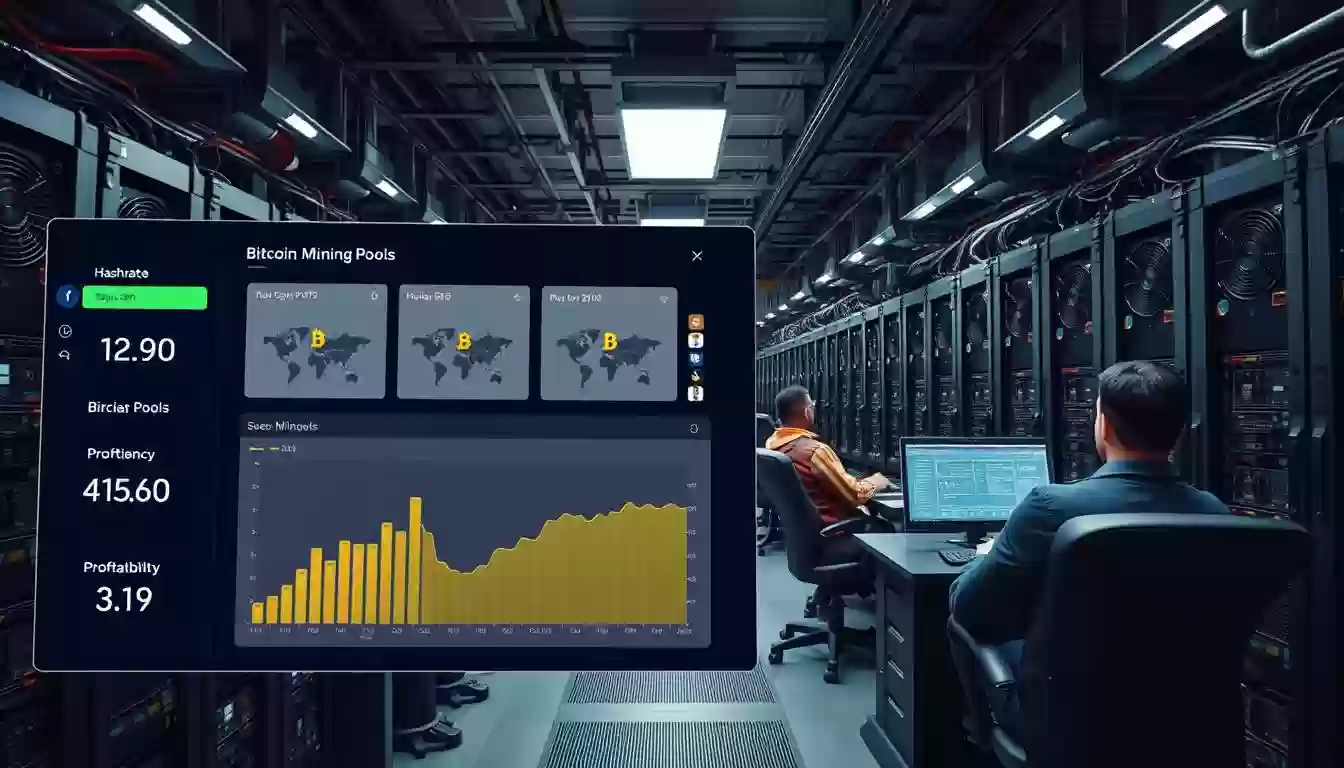Bitcoin Mining Pool Comparison: Top Picks for Beginners
 01 Mar 25
01 Mar 25
Bitcoin mining pools have revolutionized the way individuals participate in cryptocurrency mining. Initially, solo mining was the norm, but as the network's difficulty increased, it became impractical for solo miners to compete. This shift led to the rise of mining pools, where miners combine their computational power to increase the odds of solving complex mathematical puzzles and earning rewards.
For those new to the world of cryptocurrency, joining a mining pool is essential. These pools offer consistent payouts and make mining more accessible. In this guide, we'll explore top mining pools like F2Pool, Foundry USA, and Braiins Pool, among others. We'll also discuss key metrics such as hash rate and payout methods to help you make an informed decision.
Whether you're looking to understand how mining pools operate or seeking the best options for your needs, this guide is tailored for you. We'll break down the benefits and details of each pool, ensuring you have the knowledge to start your mining journey confidently.
Introduction to Bitcoin Mining Pools
Collaborative efforts have transformed how individuals engage in cryptocurrency mining. Mining pools are groups where miners combine their computational resources to enhance their chances of solving complex mathematical puzzles. This collaborative approach has become essential in today's mining landscape.
What Are Mining Pools?
Mining pools are collectives where individual miners contribute their computational power, known as hash rate, to solve blocks faster. By pooling resources, participants increase their chances of earning rewards. Each miner's contribution is measured, and rewards are distributed transparently based on their share of the work done.
Why Pools Are Essential for Beginners
For those new to mining, pools offer steady payouts and lower entry barriers. Solo mining is challenging due to the high computational power required. Pools provide a more stable income stream, making mining accessible and less volatile for newcomers.
Pools charge fees to operate, which are deducted from miners' rewards. These fees vary, so choosing a pool with a favorable fee structure is crucial. Payout methods differ too, with options like PPS (Pay Per Share) offering predictable income, while PPLNS (Pay Per Last N Shares) may provide higher rewards but with more variance.
History and Evolution of Bitcoin Mining
In the early days of cryptocurrency, mining was a much simpler process. Individual miners could use their personal computers to solve mathematical puzzles and validate transactions. This method, known as solo mining, was feasible when the network's difficulty was low.
Solo Mining in the Early Days
The rise of cryptocurrency brought with it a new wave of enthusiasts eager to participate. Solo mining allowed individuals to operate independently, relying on their own computational power to solve complex puzzles. This approach was rewarding in the early days when competition was scarce.
The Rise of Cooperative Mining Pools
As the network's hash rate demands grew, solo mining became less practical. This led to the emergence of cooperative mining pools. By combining their computational resources, miners increased their chances of solving blocks and earning rewards. Companies like Bitmain Technologies played a significant role in shaping this collaborative landscape.
Increased Network Power and Collaboration
Over time, the power of the network has grown exponentially. Mining pools have become essential for consistent earnings. The collaboration within these pools ensures that miners can compete effectively, even as the computational requirements continue to rise.
Overview of Solo vs. Pool Mining
Understanding the differences between solo and pool mining is crucial for anyone looking to venture into cryptocurrency mining. Each method has its unique advantages and challenges, catering to different types of miners.
Advantages and Challenges of Solo Mining
Solo mining allows miners to retain the entire block reward, which can be substantial. However, the likelihood of solving a block independently is extremely low. This method requires significant computational power, often necessitating a large investment in specialized hardware. Additionally, solo miners face high variance, meaning they might go extended periods without earning any rewards.
Despite these challenges, some miners prefer the independence and potential for full rewards that solo mining offers. It’s essential to weigh the high risk against the potential reward when considering this approach.
Benefits of Joining a Mining Pool
Mining pools offer a more stable and predictable income stream through payout methods like PPS and PPLNS. These methods ensure that miners receive consistent payouts, reducing the variance associated with solo mining. By combining computational resources, pool members increase their chances of solving blocks more frequently.
Pools also provide accessible entry points for newcomers, as they don’t require the same level of investment as solo mining. The shared resources and expertise within a pool can lead to more efficient mining operations and better overall results.
| Method | Advantages | Challenges |
|---|---|---|
| Solo Mining | Full block rewards Independence |
High variance Requires significant computational power |
| Pool Mining | Consistent payouts Lower entry barriers |
Shared rewards Fees deducted |

Choosing the right method depends on a miner’s risk tolerance and operational preferences. While solo mining appeals to those seeking autonomy and potential high rewards, pool mining offers stability and accessibility for most miners.
How Mining Pools Operate and Distribute Rewards
Mining pools are structured to maximize efficiency and fairness in reward distribution. By combining computational resources, participants increase their chances of solving complex mathematical puzzles required to validate transactions on the network.
Mining Shares and Hash Rate Importance
In a mining pool, each miner contributes their computational power, measured by hash rate. The pool server assigns work to miners, who submit shares as proof of their contribution. The more shares a miner submits, the higher their contribution to the pool's success. This system ensures that rewards are distributed proportionally based on each miner's effort.
Common Reward Models (PPS, PPLNS, FPPS)
Mining pools use various reward models to distribute earnings. The Pay-Per-Share (PPS) model offers a fixed payment for each share, providing steady earnings but often with higher fees. The Full-Pay-Per-Share (FPPS) model includes transaction fees in payouts, potentially increasing rewards. The Pay-Per-Last-N-Shares (PPLNS) model rewards miners based on shares submitted over a specific timeframe, which may lead to higher payouts over time but with more variance. Each model balances consistency and potential rewards differently, catering to different miner preferences.
Understanding these operational details is crucial for making informed decisions. By aligning your preferences with the right reward model, you can optimize your mining experience and maximize your earnings within the cryptocurrency network.
Bitcoin Mining Pool Comparison: Framework & Criteria
To effectively compare mining pools, it's essential to use a structured framework. This framework should focus on key metrics such as hash rate, payout structures, and fee percentages. By evaluating these elements, users can make informed decisions that align with their mining goals.
Key Metrics and Fee Structures
Hash rate is a critical metric as it indicates a pool's computational power. A higher hash rate generally means better chances of solving blocks and earning rewards. Fee structures also play a significant role. For instance, Foundry USA operates on an FPPS model with a fee of around 4%, while F2Pool uses a PPS model with a slightly lower fee of 3%. These differences can impact overall profitability.
Evaluating Hash Rate and Market Share
Market share is another important factor. Pools with a larger market share tend to offer greater stability and trust. For example, Antpool holds about 15% of the network, ensuring consistent payouts. Evaluating hash rate distribution helps users understand how their contributions impact the pool's success. This transparency is crucial for building trust and ensuring reliable operations.

By considering these metrics and support options, miners can choose a pool that best fits their needs. Whether prioritizing fees, hash rate, or market presence, this framework provides a clear path to optimal pool selection.
In-Depth Review of Top Mining Pools
The landscape of cryptocurrency is shaped by collaborative efforts, where miners unite to enhance their chances of solving complex puzzles. This section delves into the top mining pools, examining their operational methods, fee structures, and market presence.
F2Pool, Foundry USA Pool, and Braiins Pool
F2Pool stands out with a 2.5% pool fee and supports payout methods like PPS and FPPS. Foundry USA, operating on an FPPS model with a 4% fee, offers a higher market share, ensuring stability. Braiins Pool, known for its 2% fee and PPLNS method, is favored for its consistent payouts and lower operational thresholds.
Antpool, ViaBTC, and Clover Pool
Antpool, with fees up to 4%, uses both PPS and PPLNS methods, appealing to miners seeking flexibility. ViaBTC, charging up to 4%, offers PPS+ and PPLNS, balancing consistency and potential rewards. Clover Pool, with a competitive 2% fee, is known for its user-friendly interface and lower payout thresholds, making it accessible for newcomers.
Each pool's operational requirements and fees impact a miner's chance of consistent earnings. By evaluating these factors, miners can choose a pool that aligns with their goals, optimizing their mining experience for better returns.
Key Factors to Consider When Choosing a Mining Pool
Selecting the right mining pool is a critical decision for any cryptocurrency enthusiast. With so many options available, it’s important to evaluate several key factors to ensure you make an informed choice.
Pool Fees and Payout Methods
One of the first things to consider is the fee structure. Most pools charge between 2% and 4% of your earnings. For example, F2Pool operates with a 2.5% fee, while Foundry USA charges around 4%. These fees can significantly impact your profitability over time.
Payout models also vary. Pay-Per-Share (PPS) offers steady earnings, while Pay-Per-Last-N-Shares (PPLNS) may provide higher rewards but with more variance. Understanding these models will help you choose a pool that aligns with your financial goals.
Trust is another crucial factor. Reputable platforms like those operated by Bitmain Technologies, one of the largest names in the industry, offer reliability and transparency. Their track record and operational ties to established companies can give you peace of mind.
Finally, consider the pool’s contribution to the network. A larger market share often means greater stability and security. By evaluating these factors, you can select a pool that balances profitability with security, ensuring a rewarding mining experience.
Expert Tips for Optimizing Your Mining Rewards
Maximizing your mining rewards requires a combination of strategic planning and the right tools. Whether you're a seasoned miner or just starting out, these expert tips will help you enhance your mining performance and achieve consistent earnings.
Strategies for Consistent Earnings
To maximize your rewards, consider the following strategies:
- Switch payout methods based on market conditions to align with your financial goals.
- Regular maintenance of your equipment ensures optimal performance and reduces downtime.
- Adjust operational settings to suit your mining needs, such as tweaking your hash rate or power consumption.
Tools for Monitoring Performance
Utilize advanced monitoring tools to track and optimize your mining performance:
- Mining Pool Analytics provides real-time insights into your contributions and earnings.
- Hash Rate Monitors help you track your computational power and identify potential issues.
- Performance Tracking Software offers detailed reports on your mining activities and efficiency.
By implementing these strategies and leveraging the right tools, you can significantly improve your mining efficiency and achieve higher rewards. Remember, consistent monitoring and adjustments are key to long-term success in the cryptocurrency mining space.
Conclusion
As we conclude our journey through the world of cryptocurrency mining pools, it's clear that these platforms have transformed how individuals contribute to the network. The evolution from solo mining to collaborative efforts highlights the importance of adaptability and efficiency in this dynamic field.
Choosing the right mining pool is a decision that significantly impacts your success. Factors such as pool fees, hash rate, and payout structures are crucial in determining the best fit for your mining goals. Whether you prefer the stability of PPS or the potential rewards of PPLNS, understanding these models is key to optimizing your earnings.
Cloud mining continues to emerge as a viable option for those looking to participate without heavy upfront investments. With the global adoption of cryptocurrency growing, the structure of mining pools is becoming more sophisticated, offering flexible solutions that cater to a diverse range of miners.
As you embark on your mining journey, remember to utilize the framework and expert tips provided in this guide. These tools will help you navigate the ever-evolving landscape and make informed decisions that align with your objectives.
Looking ahead, the future of cryptocurrency mining is bright. Advances in technology and the expansion of cloud mining services are set to make mining more accessible and efficient than ever. Embrace this evolving world with confidence, knowing that the right strategies and resources are at your disposal.
FAQ
What is a Bitcoin mining pool?
A Bitcoin mining pool combines the computational resources of multiple miners to increase the chances of successfully mining a block and earning rewards. By pooling their hash rates, participants share both the work and the rewards proportionally.
Why are mining pools essential for beginners?
Mining pools are crucial for beginners because they provide a more stable and consistent income. Solo mining can take a long time to yield rewards, while pools allow new miners to earn smaller, regular payouts by contributing to a collective effort.
How are mining rewards distributed in a pool?
Rewards in a mining pool are typically distributed based on each miner's contribution to the pool's total hash rate. This can be through methods like PPS (Pay-Per-Share) or PPLNS (Pay-Per-Last-N-Shares), ensuring fair distribution of rewards.
What is the difference between PPS and PPLNS?
PPS offers a fixed reward for each share contributed, providing consistent payouts regardless of the block found. PPLNS rewards miners based on their contribution to the last N shares before a block is found, offering variable but potentially higher payouts.
How do I choose a reliable mining pool?
When selecting a mining pool, consider factors like pool size, hash rate, fee structure, payout method, and reputation. Larger pools offer more frequent payouts but smaller rewards per miner, while smaller pools may offer larger rewards but less frequently.
What are pool fees and how do they work?
Pool fees are charges deducted from miners' rewards to cover the pool's operational costs. These fees typically range between 1-3% of the rewards and vary depending on the pool's services and reliability.
How does hash rate affect my mining rewards?
A higher hash rate increases your contribution to the pool, leading to a larger share of the rewards. However, the relationship isn't linear, and other factors like pool size and luck also play significant roles in reward distribution.





























